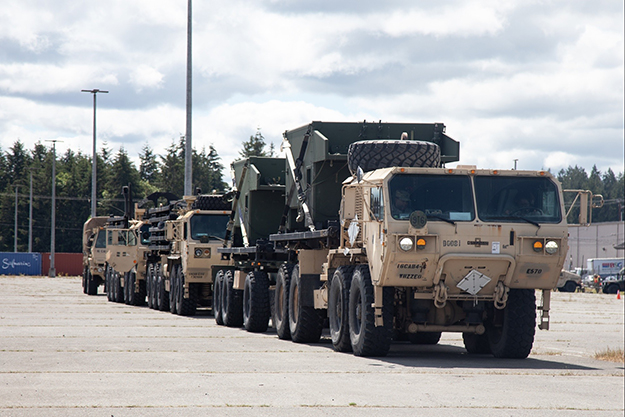The U.S. Army's 'Rapid Removal of Excess' (R2E) program, spearheaded by Gen. Randy George, is underway on Joint Base Lewis-McChord and aims to free up units from obsolete materiel by removing excess equipment from property books so soldiers can refocus their time and energy on training instead of burdensome inventories and maintenance for defunct items. This initiative, initially piloted by Army Materiel Command (AMC) and Forces Command (FORSCOM), is now a fully operational program available at all Modernization Displacement and Repair Sites (MDRS) and Army installations worldwide.
During the pilot of R2E at Fort Liberty and Fort Stewart in early 2024, units processed more than 37,000 pieces of equipment for turn-in over an eight-week window. Since early June, units on JBLM have turned in over 14,000 pieces of equipment, totaling $150,000,000. The 7th Infantry Division is set to turn in an additional 23,000 pieces of excess and outdated equipment in the next month, significantly reducing storage needs, maintenance demands, and accountability requirements across the formation.
A critical difference that makes R2E such a successful program for property turn-ins is that, unlike traditional property turn-in procedures, R2E is designed with expediency in mind.
"By utilizing R2E's ‘as-is' turn-in standard, units increase their readiness rating," said Maj. Jake Ross, a logistics officer with the 593rd Expeditionary Sustainment Command and the lead planner for the R2E program at JBLM.
"By relieving units of this equipment, commands can shift more focus on training their units for upcoming missions and maintaining a reduced amount of equipment. Additionally, units are no longer burdened with trying to maintain and account for excess equipment that is no longer authorized."
Commands across JBLM have welcomed the program and have offered their full support.
Col. Bryan Schott, the Chief of Staff for the 7th Infantry Division and the largest Army formation on JBLM, is one of the leaders supporting the effort.
"Let's talk about readiness," said Schott. "This division consistently trains and supports various activities across the Indo-Pacific. From rotations to the Republic of Korea to exercises like Cobra Gold and Hanuman Guardian in Thailand, these soldiers are adept at deploying quickly and efficiently to support theater requirements."
"But let's consider how much more agile and responsive our Stryker brigades and combat aviation brigade can be once these units are no longer burdened by managing unnecessary equipment. We're talking about a significant improvement in how quickly we can respond to regional challenges. Streamlining our property management, as we are doing now, is beneficial for our units and partners across the region."
Since this initiative was introduced to JBLM, units like the 16th Combat Aviation Brigade have leaned into supporting the program.
"We were able to turn in four pages of our property book, totaling over a hundred pieces (of equipment) and five pieces of rolling stock," since supporting R2E, said Capt. Collin Wiener, company commander for the Headquarters and Headquarters Company, 16th Combat Aviation Brigade.
"This has helped us to realign our property book with the MTOE and alleviate property requirements for the supply team, the sub-hand receipt holders, and myself. This will save us time on monthly inventories, and I expect it to reduce our 100% inventories by about two days."
With formations seeing the immediate impacts of R2E, leaders anticipate that shrinking property books and focusing on the equipment critical to core missions will be crucial in achieving a more agile, less vulnerable force.
Moreover, in addition to time saved on inventories, units can now focus their energy and maintenance efforts on mission-critical equipment, instead of the excess and non-essential equipment they had been maintaining on their property books, said Maj. Clarissa White, a Logistician with the 16th Combat Aviation Brigade.
"It's yet to be realized the full benefit of the initiative in terms of our ability to meet mission, but an immediate impact is seen in our ground maintenance workload and ability to preserve vital resources and apply them to more pressing priorities," said White.
"Soldiers will no longer have to PMCS or conduct scheduled maintenance on property the CAB (combat aviation brigade) does not want or need."
In addition to supporting theatre readiness requirements, commanders at installations like JBLM are using the program to ensure that units impacted by Army Structure (ARTSRUC) changes can turn in excess equipment. AMC's role in this is pivotal, as they handle equipment repair before it is redistributed, sold, or divested, ensuring an efficient reutilization of Army property. To date, over 210,000 pieces of equipment have been turned in through R2E, with more than 14,000 already turned in from JBLM with another month left in the program.
No longer a pilot initiative, the Rapid Removal of Excess program aims to be as seamless as possible for units. It represents a significant shift in the Army's efforts to modernize formations and enhance unit readiness. By expediting the turn-in process, units across the Army can streamline property books to critical equipment to operate more efficiently, respond more rapidly, and focus on core missions with fewer distractions. As conditions evolve in the Indo-Pacific, programs like R2E ensure that formations will be better able to meet any enduring or emerging challenge.





Read Comments